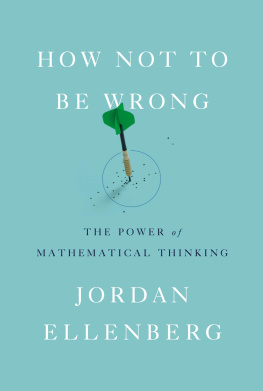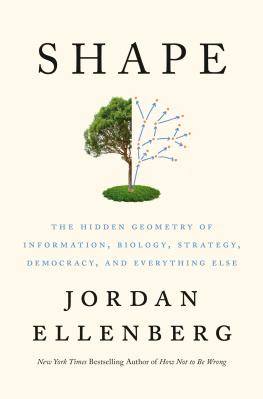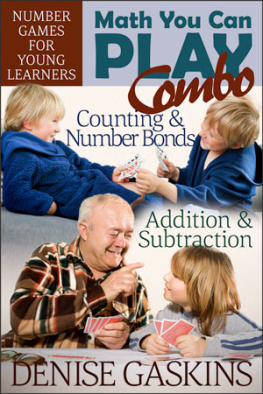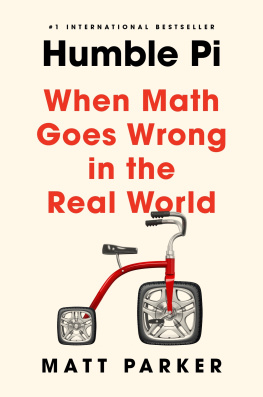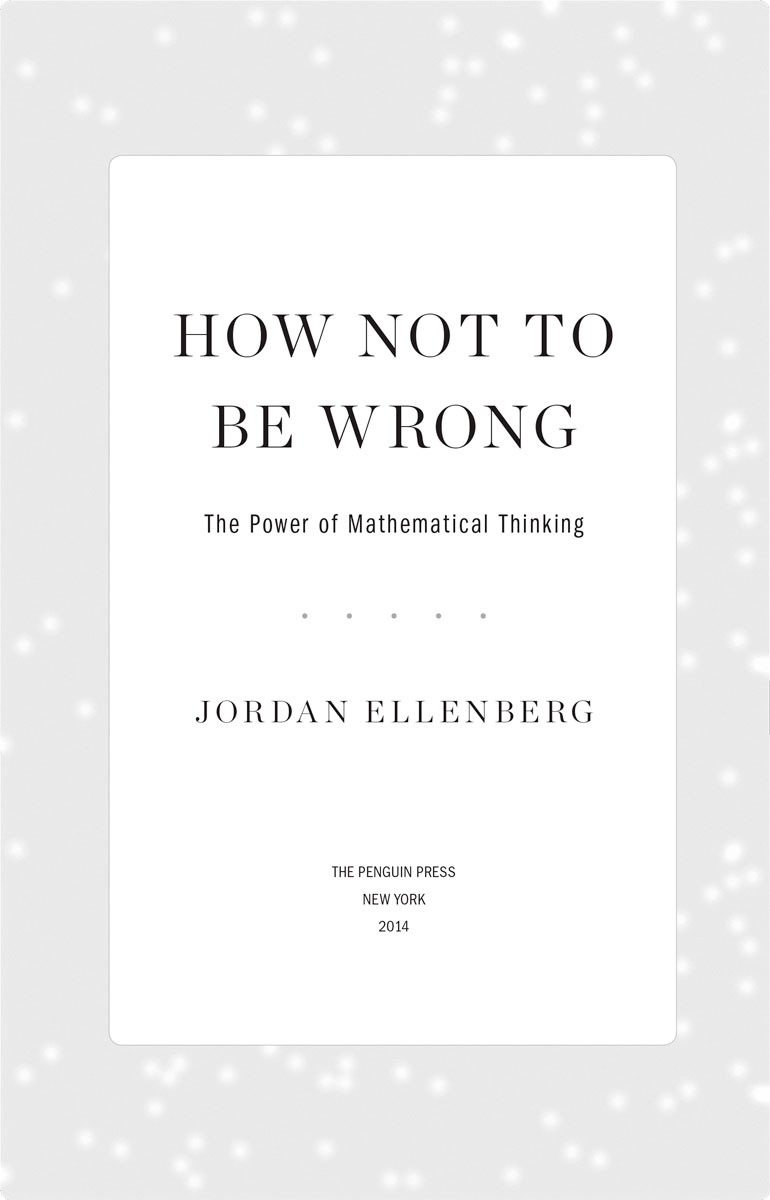THE PENGUIN PRESS
Published by the Penguin Group
Penguin Group (USA) LLC
375 Hudson Street
New York, New York 10014

USA Canada UK Ireland Australia New Zealand India South Africa China
penguin. com
A Penguin Random House Company
First published by The Penguin Press, a member of Penguin Group (USA) LLC, 2014
Copyright 2014 by Jordan Ellenberg
Penguin supports copyright. Copyright fuels creativity, encourages diverse voices, promotes free speech, and creates a vibrant culture. Thank you for buying an authorized edition of this book and for complying with copyright laws by not reproducing, scanning, or distributing any part of it in any form without permission. You are supporting writers and allowing Penguin to continue to publish books for every reader.
Grateful acknowledgment is made for permission to reprint excerpts from the following copyrighted works:
Soonest Mended from The Double Dream of Spring by John Ashbery. Copyright 1966, 1970 by John Ashbery. Reprinted by permission of Georges Borchardt, Inc., on behalf of the author.
Sitting on a Fence, words and music by Ian Cullimore and Paul Heaton. Copyright 1986 Universal Music Publishing Ltd. and Universal / Island Music Ltd. All rights in the United States and Canada controlled and administered by Universal Polygram International Publishing, Inc. All rights reserved. Used by permission. Reprinted by permission of Hal Leonard Corporation.
LIBRARY OF CONGRESS CATALOGING-IN-PUBLICATION DATA
Ellenberg, Jordan, 1971- author.
How not to be wrong : the power of mathematical thinking / Jordan Ellenberg.
pages cm
Includes bibliographical references and index.
ISBN 978-0-698-16384-3
1. MathematicsMiscellanea. 2. Mathematical analysisMiscellanea. I. Title.
QA99.E45 2014
510dc23 2014005394
Version_1
for Tanya
What is best in mathematics deserves not merely to be learnt as a task, but to be assimilated as a part of daily thought, and brought again and again before the mind with ever-renewed encouragement.
B ERTRAND R USSELL, The Study of Mathematics (1902)
CONTENTS
WHEN AM I GOING TO USE THIS?
R ight now, in a classroom somewhere in the world, a student is mouthing off to her math teacher. The teacher has just asked her to spend a substantial portion of her weekend computing a list of thirty definite integrals.
There are other things the student would rather do. There is, in fact, hardly anything she would not rather do. She knows this quite clearly, because she spent a substantial portion of the previous weekend computing a differentbut not very differentlist of thirty definite integrals. She doesnt see the point, and she tells her teacher so. And at some point in this conversation, the student is going to ask the question the teacher fears most:
When am I going to use this?
Now the math teacher is probably going to say something like:
I know this seems dull to you, but remember, you dont know what career youll chooseyou may not see the relevance now, but you might go into a field where itll be really important that you know how to compute definite integrals quickly and correctly by hand.
This answer is seldom satisfying to the student. Thats because its a lie. And the teacher and the student both know its a lie. The number of adults who will ever make use of the integral of (1 3x + 4x2)2 dx, or the formula for the cosine of 3, or synthetic division of polynomials, can be counted on a few thousand hands.
The lie is not very satisfying to the teacher, either. I should know: in my many years as a math professor Ive asked many hundreds of college students to compute lists of definite integrals.
Fortunately, theres a better answer. It goes something like this:
Mathematics is not just a sequence of computations to be carried out by rote until your patience or stamina runs outalthough it might seem that way from what youve been taught in courses called mathematics. Those integrals are to mathematics as weight training and calisthenics are to soccer. If you want to play soccerI mean, really play, at a competitive levelyouve got to do a lot of boring, repetitive, apparently pointless drills. Do professional players ever use those drills? Well, you wont see anybody on the field curling a weight or zigzagging between traffic cones. But you do see players using the strength, speed, insight, and flexibility they built up by doing those drills, week after tedious week. Learning those drills is part of learning soccer.
If you want to play soccer for a living, or even make the varsity team, youre going to be spending lots of boring weekends on the practice field. Theres no other way. But now heres the good news. If the drills are too much for you to take, you can still play for fun, with friends. You can enjoy the thrill of making a slick pass between defenders or scoring from distance just as much as a pro athlete does. Youll be healthier and happier than you would be if you sat home watching the professionals on TV.
Mathematics is pretty much the same. You may not be aiming for a mathematically oriented career. Thats finemost people arent. But you can still do math. You probably already are doing math, even if you dont call it that. Math is woven into the way we reason. And math makes you better at things. Knowing mathematics is like wearing a pair of X-ray specs that reveal hidden structures underneath the messy and chaotic surface of the world. Math is a science of not being wrong about things, its techniques and habits hammered out by centuries of hard work and argument. With the tools of mathematics in hand, you can understand the world in a deeper, sounder, and more meaningful way. All you need is a coach, or even just a book, to teach you the rules and some basic tactics. I will be your coach. I will show you how.
For reasons of time, this is seldom what I actually say in the classroom. But in a book, theres room to stretch out a little more. I hope to back up the grand claims I just made by showing you that the problems we think about every dayproblems of politics, of medicine, of commerce, of theologyare shot through with mathematics. Understanding this gives you access to insights accessible by no other means.
Even if I did give my student the full inspirational speech, she mightif she is really sharpremain unconvinced.
That sounds good, Professor, shell say. But its pretty abstract. You say that with mathematics at your disposal you can get things right youd otherwise get wrong. But what kind of things? Give me an actual example.
And at that point I would tell her the story of Abraham Wald and the missing bullet holes.
ABRAHAM WALD AND THE MISSING BULLET HOLES
This story, like many World War II stories, starts with the Nazis hounding a Jew out of Europe and ends with the Nazis regretting it. Abraham Wald was born in 1902 in what was then the city of Klausenburg in what was then the Austro-Hungarian Empire. By the time Wald was a teenager, one World War was in the books and his hometown had become Cluj, Romania. He was the grandson of a rabbi and the son of a kosher baker, but the younger Wald was a mathematician almost from the start. His talent for the subject was quickly recognized, and he was admitted to study mathematics at the University of Vienna, where he was drawn to subjects abstract and recondite even by the standards of pure mathematics: set theory and metric spaces.

